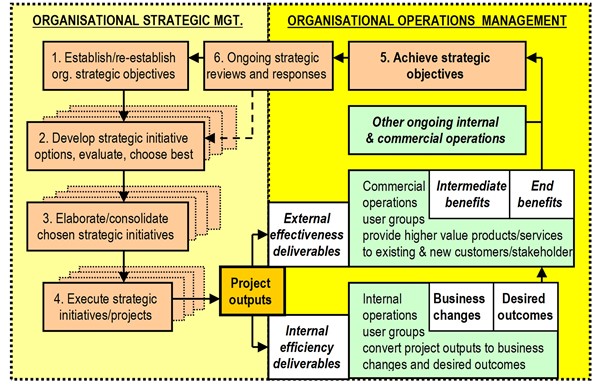into assets and organisational benefits;
relevant organisational contexts; and
a three-zone representation of an organisational
strategic/operational model
FEATURED PAPER
By Alan Stretton, PhD (Hon)
Sydney, Australia
INTRODUCTION
My three most recent articles in this journal have represented processes by which users convert project outputs into beneficial organisational outcomes. These post-project-delivery phases, and the key role of users in conversion processes, are poorly covered in the literature. This article first consolidates and extends some of my earlier materials to provide an extended basic framework for mapping these processes, within an overall organisational strategic and operational context. It then goes on to briefly present some broader contexts in which organisations operate, which are also relevant to these processes. Finally, a three-part zoning of the organisational strategic and operational framework is proposed, to facilitate future discussions.
We first briefly summarise materials presented in my three most recent articles.
REPRESENTING USERS CONVERTING PROJECT OUTPUTS TO ORG. BENEFITS
Stretton 2021k and 2021l used a recursive organisational strategic-and-operations framework as a basis for discussing and presenting specific schematic representations of user groups converting project outputs into operational outcomes and benefits. Figure 1 below is an upgraded and streamlined version of the final Figure 9 in Stretton 2021l.

Figure 1. Schematic representation of project outputs users converting them to outcomes/benefits
This figure shows two types of project outputs – internal efficiency and external effectiveness deliverables. The latter is a contraction of Figure 13 of Stretton 2021k, which identified two types of external effectiveness processes, described simply as shorter-term and longer-term. We will be expanding on these shortly. But, in the meantime, it is noted that there are no indicators in the above figure about the types of processes involved in users converting project outputs/deliverable to outcomes and benefits. This brings us to the most recent of my articles, Stretton 2021m, on the subject of asset creation, and projects.
TYPES OF ASSETS, AND PROJECT OUTPUTS/DELIVERABLES
Stretton 2021m was concerned with types of assets, and direct relationships between them and project deliverables. I quoted from Giammalvo 2021a, who equated the products of projects directly with assets, in discussing “…the products (= ASSETS) these projects are producing …”.
This correspondence of project deliverable and assets is echoed by Driver & Seath 2015, as illustrated in Figure 2.

Figure 2: The PRUB path from assets creation to benefits – based on Driver & Seath 2015
Now, at the risk of appearing to be somewhat pedantic, I should add that I do not regard the output (product) of a project as being an asset until its users actually activate it, thereby converting it from a potential asset to an active asset, whose use then contributes to ultimate benefits for the organisation.
The exploration of the nature of assets in Stretton 2021m identified the following types of assets, as summarised in the top section of Figure 3 below.
- Fixed Assets } Physical
- Current assets } assets
- Financial assets
- Intangible assets
- Information assets
- Human assets
- Internal operational assets
The first six types of assets were derived from the Institute of Asset Management’s (IAM’s) PAS 55-2:2008, Asset Management, Part 2: Guidelines for the application of PAS 55-1 (which was first drawn to my attention by Paul Giammalvo). Stretton 2021m also discussed and illustrated the many interfaces between most of these types of assets.
Stretton 2021m argued the case for adding internal operational assets, which appear to flow rather naturally from the above IAM document, particularly in the context of the internal efficiency initiatives sector of organisational strategic management.
More…
To read entire paper, click here
How to cite this article: Stretton, A. (2021). Representing users converting project outputs into assets and organisational benefits; relevant organisational contexts; and a three-zone representation of an organisational strategic/operational model, PM World Journal, Vol. X, Issue XI, November. Available online at https://pmworldlibrary.net/wp-content/uploads/2021/11/pmwj111-Nov2021-Stretton-Project-outputs-users-assets-benefits.pdf
About the Author

Alan Stretton, PhD
Faculty Corps, University of Management
and Technology, Arlington, VA (USA)
Life Fellow, AIPM (Australia)
![]()
Alan Stretton is one of the pioneers of modern project management. He is currently a member of the Faculty Corps for the University of Management & Technology (UMT), USA. In 2006 he retired from a position as Adjunct Professor of Project Management in the Faculty of Design, Architecture and Building at the University of Technology, Sydney (UTS), Australia, which he joined in 1988 to develop and deliver a Master of Project Management program. Prior to joining UTS, Mr. Stretton worked in the building and construction industries in Australia, New Zealand and the USA for some 38 years, which included the project management of construction, R&D, introduction of information and control systems, internal management education programs and organizational change projects. He has degrees in Civil Engineering (BE, Tasmania) and Mathematics (MA, Oxford), and an honorary PhD in strategy, programme and project management (ESC, Lille, France). Alan was Chairman of the Standards (PMBOK) Committee of the Project Management Institute (PMI®) from late 1989 to early 1992. He held a similar position with the Australian Institute of Project Management (AIPM), and was elected a Life Fellow of AIPM in 1996. He was a member of the Core Working Group in the development of the Australian National Competency Standards for Project Management. He has published over 230 professional articles and papers. Alan can be contacted at alanailene@bigpond.com.au.
To see more works by Alan Stretton, visit his author showcase in the PM World Library at http://pmworldlibrary.net/authors/alan-stretton/









